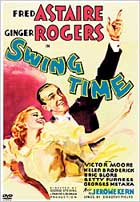
BUY IT AT AMAZON:
CLICK HERE!
STUDIO: Warner Bros.
MSRP:
$13.98
RATED: NR
RUNNING TIME: 104 Minutes
SPECIAL
FEATURES:
• Audio Commentary by
John Mueller, author of Astaire Dancing
• New Featurette: The Swing of Things:
Swing Time Step by Step
• Musical short: Hotel a la
Swing
• Classic Cartoon: Bingo
Crosbyana
• Original Theatrical Trailer
Serendipity might have played a factor in Astaire & Rogers’ 6th collaboration together – Swing Time – but these were just two performers who knew how to work together and do it so transcendently well. It doesn’t hurt that they brought acclaimed filmmaker George Stevens, especially since he was in the middle of one of his most creative decades, Gunga Din, Alice Adams and Penny Serenade immediately pop into mind, right before he came back a changed man from the European theater and made socially conscious films like A Place in the Sun and Giant before having more than a few problems on The Greatest Story Ever Told. Before all of that, Stevens helped in invigorating the dancing duo to new heights, ones filled with joyful glee.
Many people claim that Swing Time is Astaire & Rogers’ most finely tuned film together. I happen to agree with them. The combination of a lovely plot interspersed with tremendously believable sequences allows the further adventures of the gruesome twosome to be head and shoulders above their previous exploits, and sadly also above all of their 4 other films through the end of their lifespan together. Simply put: Swing Time is a remarkable film and most likely one of the best singing and dancing films ever committed to celluloid. Sorry, Breakin’ fans.
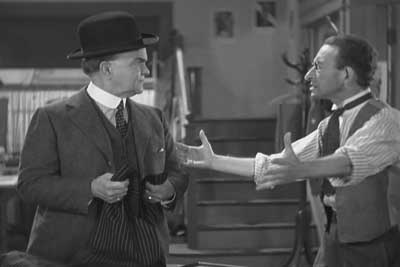
"But Stallone’s got one left in him! I tell you!"
The Flick
Fred Astaire plays John ‘Lucky’ Garnett, a man whose friends don’t have it in them to send him off to the altar. They’re all bastards, and the ultimate goal is that they make him late to his own wedding just so he won’t leave their performing troupe. Chaos ensues, and Garnett’s fiancé, Margaret, is furious along with her father. That is, until they both learn that he was making money while his friends were off ruining his big day. So, they offer him a second chance, with the understanding that he’s off to New York City to make a small fortune – $25,000 – and upon completion return to finish what his friends have destroyed and purchase a new ball-and-chain lifestyle for his bad self.
He accepts and in top hat and tails, he’s off. He quickly hitchhikes, hobo-style, on a railroad car, broken and penniless. Alongside with buddy Pop (played by the hulking Victor Moore), the pair hit the town and try to scheme a plan for a quick buck. Nothing works, and finally Garnett is forced to make change from his lucky quarter from passer-by Penny Carrol (played by the radiant Ginger Rogers), who shrugs them off on her way to The Gordon Dancing Academy, where she works, before calling a local policeman as Cossack. Astaire is, like all their movies together, instantly smitten with the anti-communism fire in her belly, so naturally, he follows her. When he finally reaches her, he promptly gets her fired.
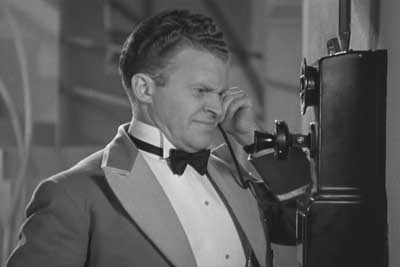
Listening to Uwe Boll was always pleasant.
In a series of good fortunes, Astaire shows the Academy’s boss Mr. Gordon (played by great supporting character actor Eric Blore), that Carrol has indeed shown the man to pick himself up and how to dance. Gordon is enthralled, and offers the pair a spot at a local nightclub (and Rogers her old job back), provided that Garnett has a tuxedo, of course. Countless escapades then ensue, usually dealing with Astaire’s handle on money (he doesn’t want to make it all – yet), as the pair learn to dance together and lover one another, all the while local big-wig band leader Ricardo Romero (Georges Metaxa) seems to have eyes only for Rogers. Metaxa’s Romero is a suave bastard, the type of non-villain antagonist that causes a barrel of problems when refusing to conduct his orchestra. He’s smugly aware that the duo have a thing for one another and he wants to break their union in half, partly because of his wholesome lust for Rogers knows no bounds. But you know what’s going to happen to him, and half of the fun is watching the plot come crashing down around him, even if it does turn him into a Baxter at the end, something he’s entirely too cheerful about.
Rogers, as Penny Carrol, brings in another one of her anchored portrayals of the ying to Astaire’s yang. Except here, she’s more radiant, more playful (the scenes where she’s attempting to get Astaire to kiss her stand out) and more enjoyable than any other effort before. Rogers’ performance works better in Swing Time because, one might say, that she and Astaire have switched roles. Usually he would be the one relentlessly courting her to little to no avail at first, but here, Rogers is the one who is relentlessly advancing on his territory after she comes to the realization that she loves him, but before his past is revealed. There’s a romantic awkwardness that the pair play off one another, especially in snowy New Amsterdam, but with Rogers it becomes the ultimate connection between the two. Her skill is immensely gratifying.
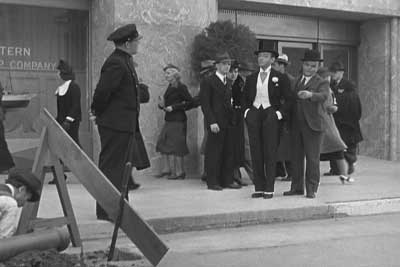
"You take that watch, and bury it over there, and
it becomes priceless, just like The Ark!"
Astaire, as Garnett, brings in one of his most enjoyable series of facial ticks, realizations and dancing feet since he hoofed it like no other a year before in Top Hat. His most triumphant moment is when he sings Never Gonna Dance, where he must woo back Rogers through a varied tempo of slow dancing, quick steps and graceful dipping that allows his abilities to speak for himself, all without words. This is the consummate performance that sums up all of Astaire’s wondrous skills for me, his adeptness, superb craftsmanship at each movement and his emotional resonance reverberate for me past all of his other films. S’marvelous.
Swing Time is a movie filled with dares: emotional ones, gambling ones (as in someone will stand on their head), and romantic ones, and it’s within these dares that the plot advances and transforms itself into probably the most cohesively entertaining film Astaire & Rogers would ever work on together. These dares equate to a series of pleasure delays as well, particularly when Fred and Ginger lean into kiss and a door is opened blocking the audience’s view from the highly anticipated moment. Or when Rogers leans into kiss Astaire in the snowy enclave in upstate NY, and Astaire breaks the moment by asking if she’s cold. Of course, she replies, and then he tells her to flap her arms, as it’ll restore circulation. The scene has taken away our amusement of the two of them finally connecting and substituted another, the frustrated joy of the delay. Additionally, the most noticeable delayer is where the pair first dance together, and while Rogers has no idea Astaire can dance (‘no one is going to teach you to dance in a million years’ she says), it’s a tremendous example of the delay as we wait for Astaire to grab her by the waist and twirl her around on the dance floor, all to our intense enjoyment.
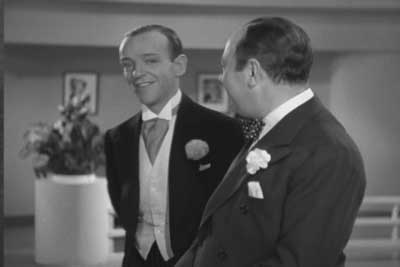
The Astaireappendage was always popping out when it shouldn’t.
There’s one scene in particular, that is going to be particularly jarring for today’s viewer. It’s the definitely-not politically correct Bojangles of Harlem sequence, where Astaire has blackface on and is surrounded by some of the whitest ladies in the history of showbiz. It’s hard to deny the cringing racist undertones of the scene, but in reality, many people don’t think it’s meant to be racist, rather Astaire seems to have tailored the scene towards paying homage to the late great Bill Robinson, by way of being somewhat offensive to today’s more modern and hardened audience. It has never really worked as a whole for me, every time I watch the film, and while it is jarring and a little off-putting, I can see where other people are coming from. That doesn’t mean I have to agree with them, though. It still feels weird, like tentacles on your back.
George Stevens, the great humanistic director who’d go on to make some amazing films later on in his life, still was in a very creative period with Swing Time and it shows. He’s breaking a few of Astaire’s "the camera dances, or I do" rules, in which he’s craning upward to show a heightened shot or moving alongside the dancing duo to give the illusion of movement, almost as if you were there with them. But he never breaks the wide shot of the pair, or the individual dancing, so it always allows you to concentrate on their amazing abilities. Stevens also injects the most amount of humanity into the plot, these are characters unlike any other Astaire & Rogers films. While they’ve always been buoyed by the likes of supporting characters like Edward Everett Horton (who’s conspicuously absent here), Swing Time feels like real people doing real things, grounded in real situations that are easily identifiable with. While there are some Art Deco sets, there’s nothing like the gigantic fantasyland of fake Italy in Top Hat, as Stevens and crew seem compelled to place the action within places people know, like nightclubs, the city streets, and snowy small towns.

My dancing skills: personified
Arguably the most cohesive and well-written Astaire & Rogers film, Swing Time is their best collaboration together and their most enjoyable. The act of watching two professionals have a tremendous amount of fun translates well past the screen and onto the viewer. Populated by an enjoyable series of narrative developments, great songs and the simple act of dancing helps elevate Swing Time into one of the better movies made during the Depression era. It’s a remarkable achievement, and a spectacular film to boot.
9.4 out of 10
The Look
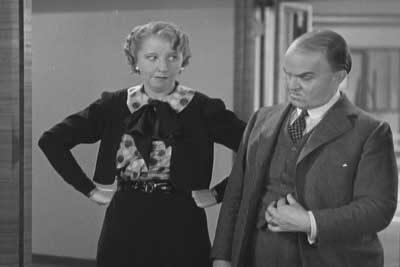
"Listen lady, I’m sorry I ate your Baby!"
Presented in the films original aspect ratio of 1.37:1. The imagery is surprisingly clear, even though you’ll notice some print damage like scratches coupled with some heavy amounts of grain. While the last part is adequate with me (grain makes a film!), it’s a tremendous piece of work for Warner Brothers to have such a relatively beautiful looking print, highlighted by some spectacularly vivid blacks and whites, that they transferred into a digital disc.
8.5 out of 10
The Noise
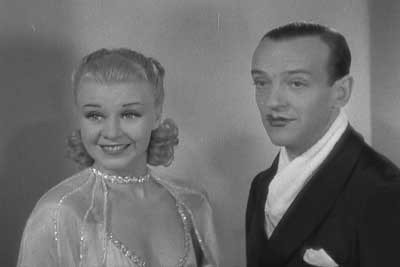
Susan seemed pretty enthralled that the splotch was The Herp.
Dolby Digital Mono. While not necessarily going to destroy your house, Hulk style, it does have a sweet and sultry mix to it, especially allowing you to hear the Swing Time waltz, which oddly enough, is addictive, like a nasty batch of crack. Although, unlike that, the mix here won’t kill you. Unless you turn it off, that is.
8.5 out of 10
The Goodies
There’s a rather dry and scholarly commentary track from John Mueller, author of Astaire Dancing. He has a lot of interesting items to comment on, from the various facts and figures of the entire film (examples include the opening that was truncated into the version that exists now, the fact that Rogers feet bleed profusely on the 10 hour day shooting Never Gonna Dance and off-the-cuff biographies of Eric Blore and Victor Moore). One major problem is that occasionally, he’ll slip into stating the obvious on screen, but those aren’t necessarily a major problem. His tone, however, appears a bit monotonous, and doesn’t really inspire anyone hearing this for the first time to be enthralled into submission, like Larry Billman’s exuberance on Top Hat‘s commentary.

The cover up your Boner game wasn’t as big a hit as planned.
The new featurette: The Swing of Things: Swing Time Step by Step, sadly does not feature a retrospective from Patrick Duffy or Suzanne Sommers. It does have a boatload of people, from John Mueller, Larry Billman and Leonard Maltin among others, discussing the wonderful aspects of Swing Time and what it means to be one of Astaire & Rogers’ greatest films. Hermes Pan’s discussion on the medium of dance being the expression of ideas will open new worlds to those uninitiated, so that was a welcome surprise. There’s a smattering of badly shot DV footage showing some very happy dancing people recreating the Astaire/Rogers steps from Pick Yourself Up, and it feels out of place with all of the stock footage (which includes some from Bill Robinson’s performances) to the relatively professionalism of the ones involving all of the people mentioned above.
The short film Hotel a la Swing (runtime: 21:37) is also included, but it’s nothing more than an exercise in showcasing a variety of different singing styles and somewhat awkward dance routines, coupled with a plethora of singing and dancing men and women who all seem to look in different places when it feels like they should all be addressing the camera singularly. The slapdash plot is centered around a down-and-out troupe getting involved with running a hotel for 90 days, but there’s a catch, as the hotel’s books seems to be cooked. That last part isn’t explored at all, rather just a device to end the short with some untied loose ends. Taken as a whole, the short is adequate, but it’s not going to set your world on fire. The bar in Hell on the 67th floor might.
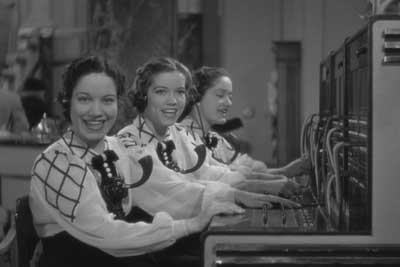
Wait, which cue cards should we be looking at?
The classical cartoon Bingo Crosbyana (runtime: 7:53) should make Bing Crosby rather irate, if he were alive and kicking. Centered around a group of flies, the most well known of which is the singing and serenading Bingo Crosbyana (he murders the weaker gender, the anti-feminist flies say), it portrays Bingo as a coward when the evil Spider comes billowing downward, running and hiding exceptionally well. The print is immaculate and the colors insanely vibrant, but the portrayal of the White Christmas man isn’t as flattering as much as it is a fun natured jab.
The theatrical trailer (runtime: 2:37) is a bouncy and bubbly piece of entertainment, scored to the waltz of the Swing Time and showcases the two stars doing what they do best, being in fake love with one another and using their incredibly fancy feet. Not bad.

Swinging Babies … always in vogue.
7.7 out of 10
The Artwork
 Thoroughly enjoyable. Astaire’s look of Scarface‘s motto: the world is yours, put together with Rogers’ demonic stare has the right amount of motion, almost beckoning you to join them as they dance the night away. While most of us New Englanders can’t really dance at all, it’s best to live out those fantasies through the cover art so ably provided. Lastly, the color scheme is great, very light and bubbly, just like the film. Work? It is done.
Thoroughly enjoyable. Astaire’s look of Scarface‘s motto: the world is yours, put together with Rogers’ demonic stare has the right amount of motion, almost beckoning you to join them as they dance the night away. While most of us New Englanders can’t really dance at all, it’s best to live out those fantasies through the cover art so ably provided. Lastly, the color scheme is great, very light and bubbly, just like the film. Work? It is done.
8.0 out of 10